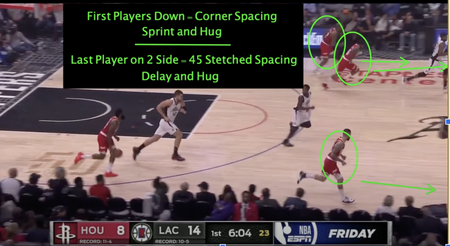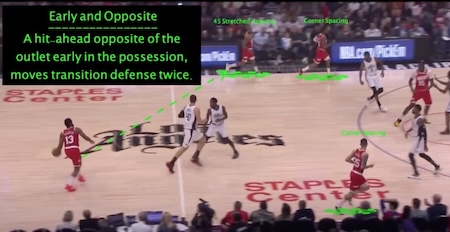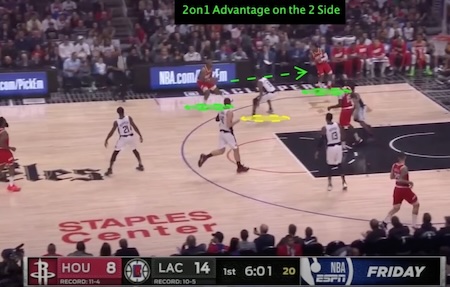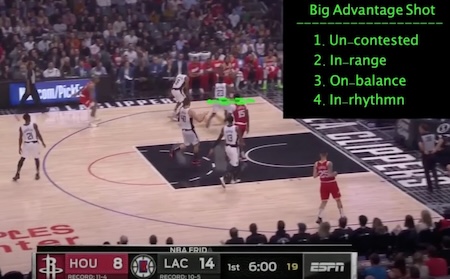A Breakdown Of 2-Sided Transition Offense With James Harden And The Houston Rockets
One of the neat facts about Coach Brent Tipton's 2-Sided Transition Offense product is that it's effective at ALL levels.
It's easy enough to teach and implement that middle school and high school teams could run it effectively...
And as you'll see right now, it's also used to dominate at the highest levels of the NBA.
I want to give you a visual of one action off the 2-Sided Transition Offense...
And this visual comes directly from James Harden and the Houston Rockets (when he was still on the team).
I'll walk you through it step-by-step so you can see why it's so effective...
As well as how the concepts could apply to your team.
As you can see in the diagram below, Harden's first order of business once he gets the pass off the rebound is to move towards the sideline:

At the same time, you can see that three other players hug the sideline (one player on Harden's side and two players on the opposite side) as they sprint down the court.
This is so that they can create maximum spacing to spread out the scrambling defense.
The next key part of this transition offense is for Harden to pass the ball to the opposite side of the floor in the first 2-3 seconds of the possession:

Ideally, the ball should cross half-court in the air. This allows you to move the ball down the court faster.
And by getting the ball to the opposite side of the floor early in the possession, it forces the defense to readjust their positioning based on the new court positioning of the ball.
They're already flat-footed on the retreat and they have to quickly change their focus from Harden to the opposite wing.
That's what creates the match up advantages you can already see starting to develop.
And now you can see the full 2-on-1 advantage once Harden swings the ball:

By sprinting ahead and hugging the sideline, the two opposite wing players force a mismatch, all while the Clippers big man is still getting back in the play.
Remember, because centers are usually near the rim on their offensive end, they must run a full 74 to 94 feet to get back on defense while your wings can get there much quicker (especially if they sprint in transition).
And finally, the last step of this action from the 2-Sided Transition is to find your shooter in the corner for a wide open jump shot.

Now this "Early and Opposite" action is just one of the scoring options you'll often see in the 2-Sided Transition. If the corner 3-point shot is taken away, there are options to:
- Drive at the OBD (off-balance defender)
- Boomerang the ball back to the wing (make an immediate return pass)
- Go into DHO action with the wing (dribble hand-off)
By drilling Early & Opposite with players, they can begin to make proper reads quickly and easily, often taking a small advantage situation and turning it into a big advantage shot!
Additionally, 2-Sided Transition also has concepts that help teams create and keep advantages off:
- Early & Up (when the ball goes down the same sideline)
- Dribble Push (when the ball crosses half-court with the dribble)
- Non-Advantage Triggers (triggers actions to create an advantage when there was not a number advantage in transition)
The variety that this conceptual approach provides is one of the best features of this fast-paced offense.
I hope this visual helped you see just how effective and easy it is to implement the 2-Sided Transition Offense.
You could even start implementing this exact action right now!
And no, you don't need NBA superstars like James Harden for this to work.
Its strength lies in its concepts...
And Coach Brent Tipton has used this to transform teams at every level–from middle school all the way to the pros.
What do you think? Let us know by leaving your comments, suggestions, and questions...
|
|||


 Facebook (76k Likes)
Facebook (76k Likes) YouTube (85k Subscribers)
YouTube (85k Subscribers) Twitter (26k Followers)
Twitter (26k Followers) Q&A Forum
Q&A Forum Podcasts
Podcasts